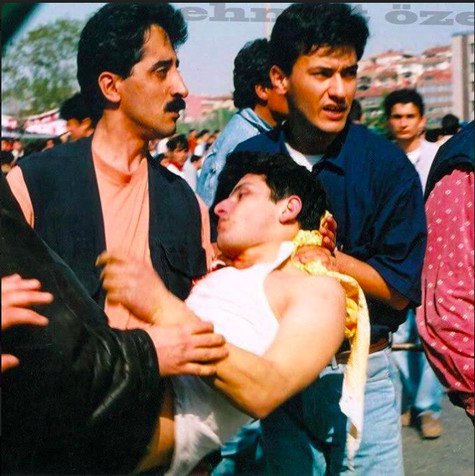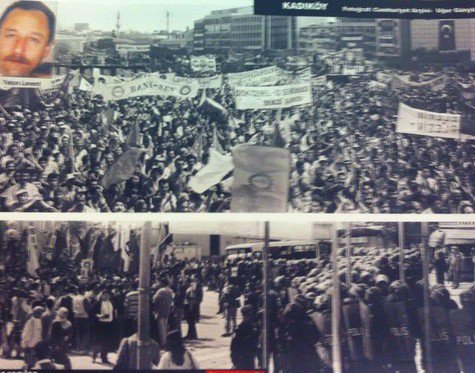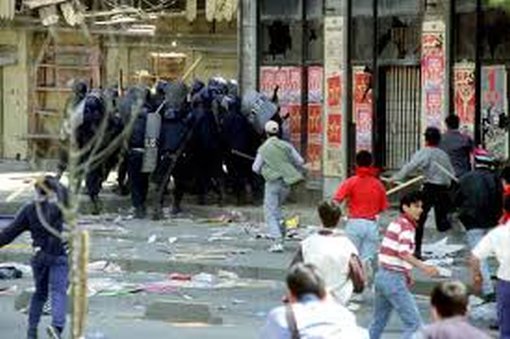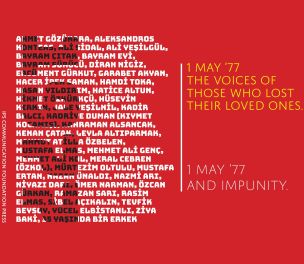The 1996 May Day celebrations İstanbul's Asian side district of Kadıköy had seen the largest crowd since May 1, 1977, when dozens of people were killed in the Taksim Square Massacre.
More than a hundred housand people were gathered in the shoreline and more people were coming. But after some groups refused to be searched, police opened fire and killed three people.
The shooting of the people triggered violent clashes that left dozens of people injured.
The mainstream media mostly covered angry people "smashing tulips" and the beating of a plainclothes police officer by demonstrators after he was found to be a police officer.
The case concerning the incidents was completed in December 2017. Sixty-three defendants stood trial for "involvement in the incidents where three people were killed and 33 security officers were injured." Thirteen of them received prison sentences of between 4 years and 11 years and 9 months.
The case of 47 defendants dropped due to statute of limitations and two cases dropped because of the defendants' deaths.
Tuğçe Yılmaz interviewed their family members and loved ones and people who witnessed their deaths for bianet.
Here is a summary of the interviews:
Dursun Odabaş
Dursun Odabaş was born in 1976 in Espiye, Giresun.
After finishing high school, he went to Bursa because he couldn't find a job in Espiye.
He and his friends set out for İstanbul for May Day.
1996 May Day was the first demonstration he had ever attended.
His cousin Yaşar Akgün says the details about his death are still unknown.
.jpg)
"I'm not his peer, his elder brother, Kazım, was my friend. I'm 63 years old now. And he would be 45 if he lived. So, he would still be young...
"After graduating from high school, Dursun went to Bursa to work with his friends because he couldn't find a job here.
"His friends were from the leftist youth. Dursun didn't have much to do with politics but of course, he had an inclination to the left.
"That night, his friends say, 'We'll go to İstanbul in the morning for May 1st. And Dursun says, 'I'm coming, too.' They go to İstanbul together.
"At the entrance of the May 1st area, while police were searching people who were entering the area, He was shot dead from afar with a single bullet.
"His funeral was in the village. In Soğukpınar town in Espiye. The funeral was held under a police blockade. Entrances and exits were taken under control, there were a lot of police officers.
"People didn't have the courage to attend the funeral. They suddenly came and left the body so that there wouldn't be a gathering.
"His family disintegrated after '96 May 1st. Dursun's mother died a very short time after him, in fact, she couldn't bear the pain of his death. And we lost his father after an accident.
"I don't know whether a case was filed after Dursun. And where the killer is known, whom will you complain about? This was what his father used to say: 'It's clear who killed. Will I file a case against the state?' As this was the case, nobody pursued it. And they covered it up.
"Why? How did it happen? Even the details are unknown.
"It was such an unreasonable situation that I still can't understand what we lived through. The boy was taken away from us for nothing."
Hasan Albayrak
Hasan Albayrak was born in 1978 in Kartal, İstanbul.
He was the child of a family from Erzincan province. He was a worker at a ceramics workshop before his killing.
1996 May Day was the first large demonstration he attended.
He lost his life after being shot by police.
.jpg)
His cousin, who has the same name as him, tells what happened:
"He had just started working. He was a worker at a ceramics workshop. Like every young person, he would hang out, perceive life, and was especially fond of football. He went to May Day for the first time, it was the first demonstration he attended and he fell martyr there.
"There was a small age difference between us, we kind of grew up together. Our name is the same. I would work in the shipyard and work actively in the union. That day, I was going to go to May 1st. My family, of course, said 'Don't go,' but I was going to go despite them.
"While I was setting out, I coincided with a friend who owned a coffee shop in the neighborhood. He said, 'Drink a cup of tea before going.' I sat in the coffee shop. I thought Kadıköy is close anyway.
"It was 10 or 11 in the morning, we had news. Because our names were the same and I was unionized, everyone thought it was me. Police went to the shipyard and to my home.
"... We went to Göztepe Hospital and learned that Hasan was shot. We confronted police officers. One police officer pushed me, saying 'Get out.' Another one said, 'Your body is not here, it's at Forensic Medicine.' We then went to Forensic Medicine.

"Our neighborhood, Tuzla İçmeler Neighborhood, is already a neighborhood with a high political awareness. Everybody took to the streets after they got the news.
"They then called us and said, 'No one should come to take the body, no crowd should be here.'
"Not much happened at the funeral but people were nervous, angry. I was 25 years old at the time, I remember what happened well.
"I wonder if that young Hasan Albayrak realized that he was exploited when he was working and the injustice in the world and attended May 1st, how a person he would be now. As a young man, he would probably be in the struggle. He would get married, have children. Maybe he would raise them like himself. Because Hasan Albayrak was a good, honest and harmless worker."
Yalçın Levent
 Photo: Uğur Günyüz
Photo: Uğur Günyüz
Yalçın Levent was born in 1976 in Ankara.
He was a correction officer. His last place of duty was the political section of the Bayrampaşa (Sağmalcılar) Prison.
He was a member of the Tüm Yargı-Sen, a union of judicial and correction officers working at prisons.
Having actively participated in the union struggle, he was in Kadıköy for May 1st. He was shot dead by police on May 1st, 1996.
Photojournalist Ali Öz was with him when he was shot.
"For 40 years, I've been trying to photograph the whole agenda of Turkey and I call this 'political documentary photography.'
"During this 40-year period, I can say that I have become an expert in how provocation is done. One of the most typical examples of these provocations was May Day '96.
"May Day '96 was the first big mass meeting in a central area like Kadıköy, attended by nearly 300,000 people. This had to be provoked. Police and the security directorate planned this job.
"The name of the third one of the killed was Levent, a boy who was a guardian. He died next to me. He was targeted from above and shot with pinpoint accuracy. Think about it, someone is lying dead next to you and there is nothing to do.
"Of course, I got nervous too, you get stressed in such a moment. On that day, three people lost their lives there, and the enthusiastic celebration of May 1st of 300 thousand people went for nothing.
"Meanwhile, there were tulips near there. A girl started to smash those tulips. I stopped taking photographs and went to speak with her about the wrongness of what she did. I said, 'What are you doing, you are smashing tulips, do something else, get angry and something else.'
"The Zaman reporter who heard this took that photo. And that photo became a symbol in every press organization, including mine, Tempo.
"And the scene of the lynching of a police officer was handed out. Broadcasts were made as if three people didn't die and the leftists went nuts, smashing flowers and lynching police officers. Especially on Star TV...
"The crowd was portrayed as aggressive, anarchists, lynchers and police were somehow tried to be portrayed as innocent. But police prepared a provocation on that day." (TY/VK)
 |
| This text was created and maintained with the financial support of the European Union provided under Etkiniz EU Programme. Its contents are the sole responsibility of "IPS Communication Foundation" and do not necessarily reflect the views of the European Union. |





.jpg)
